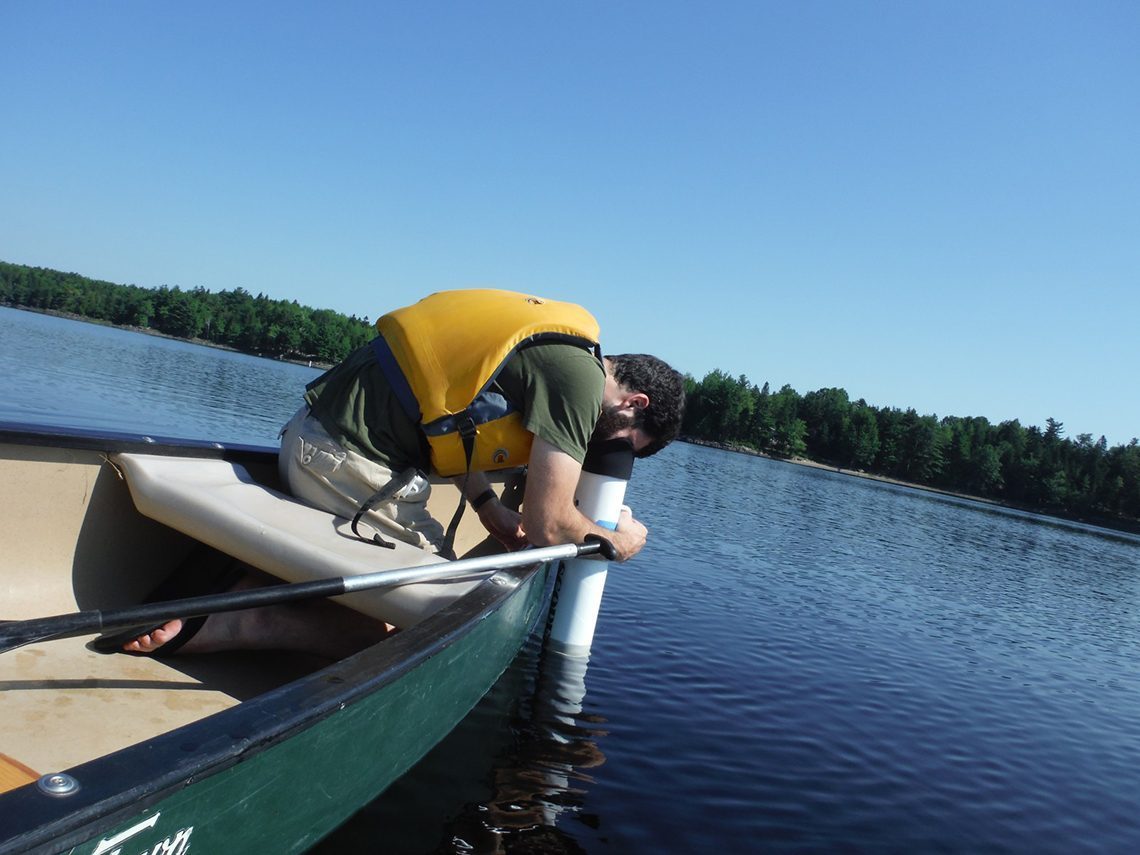
UMM Student Uses Lake Quality Monitoring to Further Research
University of Maine at Machias junior Malcolm MacDonald uses a viewing tube to peer into the waters of Gardner Lake, testing visibility levels and taking water quality measurements. MacDonald is part of a statewide network of lake water volunteers but is also able to further his own research at UMM at the same time.
MACHIAS, Maine — On a hot summer day mid-August, University of Maine at Machias junior Malcolm MacDonald paddles a canoe out towards the center of Gardner Lake. Using GPS coordinates, he returns to the deepest part of the lake, the same spot he visited two weeks ago. He drops a white and black disc attached to a measuring tape into the iron-brown water and carefully records the depth at which the disc’s markings are no longer visible. He records the time, temperature, weather and other conditions of the day.
Macdonald is part of a network of volunteer researchers across the state that carefully monitor more than 500 lakes. Along with Dr. Jeremy Nettleton, Assistant Professor of Marine Biology at UMM, MacDonald is providing key information about water quality at Hadley, Gardner, and Indian lakes in Washington County for the Maine Volunteer Lake Monitoring Project.
At the same time, since his work is not connected to an ongoing study but instead is a supported independent study, MacDonald is also advancing his own research into invasive species and networking with scientists and researchers across the state to help further his own scientific career.
[blockquote align=”left”]
“Malcolm’s project is a an excellent tie to real world scientific experience,” Nettleton said. “He has the potential to present his findings and documentation at conferences and to use his research to connect outside UMM. This could open doors for his future employment.”
[/blockquote]
MacDonald said “We correlate the information we collect with what is happening in these lakes, their quality and health. It is a good measurement of how these lakes are faring.” MacDonald said that this summer’s statistics show that overall, the three lakes he has been monitoring “are very healthy lakes.”
Although it has been a dry summer and lake levels are lower than normal, there have been no algae blooms or other issues, he said.
MacDonald and Nettleton both said the extensive training and strict protocols are an important part of both the program and MacDonald’s training as a scientist.
Formed in 1971, Maine’s VLMP is the longest-standing statewide citizen lake monitoring program in the U.S., as well as one of the largest, with more than 1,200 active volunteers monitoring more than 500 lakes statewide. Many of the volunteers have continuously monitored the health of their lake for a quarter century, or more. Much of what is known about Maine’s lakes and ponds is the result of years of dedicated effort by volunteers.
The information gathered is shared with the Maine Department of Environmental Protection, the US Environmental Protection Agency, educational institutions and research agencies, lake and watershed associations, land trusts and town governments.
Maine’s lakes have a huge impact on the environment, MacDonald said, but the economic impact of healthy lakes is just as vital, he said. The research he is part of helps inform local communities and provides a good early warning system if any problems arise regarding setting policies for watersheds and effects of development. Nettleton said he will hold Macdonald’s research for years so that future students will be able to do comparative studies.
“This program is an excellent chance for college students to do important research that positively affects their communities,” Nettleton said.
